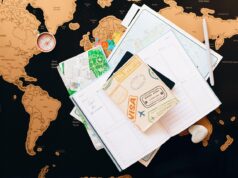By Zsarlene B. Chua
THERE WAS SOMETHING utterly magical about Siargao in Surigao del Norte — and it’s mostly because of the unspoiled beauty of the teardrop-shaped island 800 kilometers from the Philippine capital.
Getting there was a bit of a chore as one would have to ride a plane to Cebu before transferring to a smaller craft.
At first, Siargao was unassuming, especially if you had to base your first impressions on the tiny airport. At first it looks like any other province in the Philippines: full of coconut trees, lush vegetation, countless plantations, farm animals, you name it, it’s there, but that is where the similarities end and the beauty begins.
During a media trip hosted by a Japanese electronics company last May, the group of 20 or so media practitioners were unceremoniously hauled off from the airport to a boat in Del Carmen, 20 minutes away. The boat ride took an hour — which was the same amount of time we spent guessing where we were headed as our boatmen were not the talkative type.
Being in an unfamiliar place headed to an unknown destination, we were full of misgivings — especially seeing the looming storm clouds up ahead. The skies opened and we scrambled to avoid getting our devices wet. (In the hierarchy of things, the highest priority should always be keeping electronics safe. Keeping yourself safe is almost an afterthought.) Then we became aware of our amazing surroundings — we first traversed a huge mangrove forest and continued on to the sea, dodging islets and rock formations along the way.
A fifth class municipality, Del Carmen is said to be home to the largest mangrove forest reserves in Mindanao (about 4,200 hectares).
The turquiose water was so clear. It was perfect.
At the end of the journey which left everyone soaked (except me because I had the foresight to bring an umbrella), we arrived at a log cabin in a lagoon called Sugba.
“Sugba” is a Visayan term for grilling food. According to a local fisherman, its name come from the fact that when it is the time of the amihan (northeast monsoon), fog settles over the area and for some reason the lagoon’s water looks like it’s lit by fire from below — thus Sugba.
It looks like something out of Peter Pan: it looks like Mermaid Lagoon.
The log cabin is a two-story affair and is mostly open air except for a space on a second floor covered in glass panels. According to the fishermen, the structure was created by the local government to provide extra income for the fisherfolk.
One can rent a boat for six people at P1,600 and spend the day in the lagoon (and its stingless jellyfish). Those who want to stay overnight can add P800 and the fishermen-guide will stay with the group. The cabin can also be rented from P5,000 to P10,000 a night for big groups. The fisherfolk can prepare food for the group provided they are advised a few days before the trip.
After taking second breakfast (like Hobbits) there and mulling over the idea of staying the night, the media group moved on and towards General Luna, the municipality where Cloud 9 is found.
Cloud 9 is home to a type of wave surfers love because of its thick, hollow tubes. Supposedly, the home of the wave was discovered in the 1980s and named after the chocolate candy. It was featured in Surfer magazine in 1993 by American photographer John Callahan.
It is this wave that made Siargao the “Surfing Capital of the Philippines” and it’s within a 10-minute walk from our resort, Siargao Bleu Resort and Spa .
We stayed in Siargao for three days and on the second day, as much as we would’ve liked to take it easy and explore the sights that captivated us, our hosts decided that we should embark on an Amazing Race-type of game where we raced each other through the islands of Siargao. Therefore our only experience of Daku Island and the nearby Naked Island was that of suffering despite the fantastic views.
Daku, which means “big” in Visayan, is a 20-minute boat ride from General Luna. The island has a white sand beach with a texture comparable to that of Boracay. Cottages are available for rent and it seemed as if there was a small community of fisherfolk living on the island. More foreigners than locals were spotted.
Daku Island is the biggest of the Tres Marias Islands of Siargao: Daku, Guyam, and Naked Island.
We didn’t stay long on the island, which was a shame. We had to try to cook our food on a makeshift stove (sneakily giving the excess ingredients to the fisherfolk) and try to bowl using coconuts and bamboo pins in order to get the next clue.
Many of us would have wanted to spend the day on the island instead.
Guyam Island wasn’t one of our stops, but is said to be covered with coconut trees and a single hut.
Another 20-minute boat ride brought us to our next stop in the race — Naked Island (or Pansukian island). It looked more like a sandbar than an island as it was almost entirely devoid of vegetation, save a few clumps of grass here and there, thus the “naked” monicker.
Much like Daku, it has a white sand beach and is in the middle of nowhere surrounded by turquoise water. It was beautiful. Sadly we weren’t able to fully enjoy it as we were busy digging around the island for a message in the bottle.
After Naked Island, the race took us back to General Luna where it all ended and my team lost.
The Siargao experience I had barely scratched the surface, but the trip was enough to entice us all to come back as it was the kind of place one wouldn’t mind getting lost in. It really was amazing.



